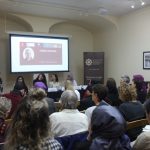Empowering Women of Faith Leadership in Society

Some religious traditions embrace the contributions of women in positions of authority within narrowly defined parameters while the gender equality in every arena of leadership should be fully recognized. Generally, the conversation about the role of women in leading religious communities involves the interpretation of sacred texts, the role of traditions, and the divine call of women.
Despite decades of positive change toward gender equality in American society, women remain under-represented in leadership positions in most major faith groups. In this event, we will highlight some of the best practices coming from the grass-root activities involving women leaders from major world religions. We will have a closer look at the leadership skills and the drive within the successful programs and investigate the key skills in mobilizing more involvement and active participation of women in leadership positions.
The topic directly examines the empowerment of women within faith communities which is a key factor in how gender roles and responsibilities are defined within the larger context. Since faith communities play a central role in definition of the gender roles, it is imperative to take a closer look at these grass-root communities to ensure a sustainable development. In this event we aim to focus on SDG Goal #16 and analyze the contribution of the women of faith leaders to create more inclusive and peaceful societies.
We expect to foster a discussion on the leadership positions of women of faith within communities and create a platform for networking opportunities for further work in this area. Our organization, North East Islamic Community Center, works on women empowerment at various levels including: (1) Partnering with other women-based organizations to foster dialogue and learning between women leaders, (2) increasing the volunteer base to include more women and youth within the organization, and (3) constantly striving to bring women into leadership positions within the organization. Our goal is to have 50% representation in the higher management roles by year 2020. Currently, our advisory board and board of directors comprise 20% and 25% women,respectively.









